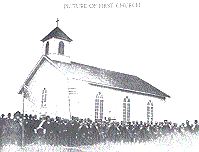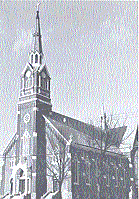In the late 1850s a small group of Polish immigrants settled in Trempealeau County, Wisconsin. They brought with them the cultural heritage of their native Poland. An important part of that heritage was their devotion to the Roman Catholic Church. The culmination of their religious zeal was the formation of Saints Peter and Paul Parish in Independence, Wisconsin, in 1875. In the ensuing century these Polish people have preserved, to some extent, the traditions of their ancestors. As a result of temperamental and historical conditions, it has been claimed that the devotion of the Polish people in Roman Catholicism surpasses that of any other nationality. America had been know to many Poles from the time of its discovery. Early immigrants were numerically small. Miecislaus Haiman divides Polish immigration to the United States into three periods: Colonial Immigration 1608 - 1776
The latter group is of interest here. It is from this group that the vast numbers of immigrants came to America. It was primarily economic reasons which brought the first settlers to Independence, Wisconsin, and led to the formation of Saints Peter and Paul Catholic Parish. It should be noted here that the first settlers of Polish descent to settle in Independence (then the Town of Burnside) came from Silesia. Silesia was an old Polish province which for six centuries vacillated between Bohemia, Germany and Austria. Although the area from which the immigrants came was a part of Germany and had a mizture of German customs and language, it remained primarily a Polish ethnic and religious grouping and the people considered themselves as Polish. Perhaps this was true because Popielow, the small rural community from which they came, was in an area that was no more than a few miles from Poland's border at anytime. Although a part of Germany from a political standpoing, they remained a part of Poland culturally. The State of Wisconsin along with other Midwestern States, was interested in populating its vast territories. Wisconsin offered the availability of farmlands which attracted the early peasant immigrants. The large city of Milwaukee had jobs in industry and presented an opportunity for the unskilled workers. Small agricultural communities attracted the early Polish settlers. The earliest Polish rural settlements in Wisconsin was Polonia in 1855. Other Polish settlements followed at Stevens Point, Marinette, Berlin, Menasha, Manitowoc, Beaver Dam, La Crosse, Pulaski, Bevant, Galloway, Green Bay, Hatley, Superior, Thorp and Independence. By 1865, the first Polish Catholic Church in Wisconsin was organized in Milwaukee. Among the Polish immigrants attracted tot he State of Wisconsin in the 1850s was the Albert Bautch family. This included Albert Bautch, born in Popielow; his wife, Josephine Bautch, whom he married in 1853 in their homeland; their small son, John L. Bautch, born in 1853 in Popielow; a brother to Albert, Lawrence Bautch; and two brothers-in-law, Peter Sura and Leopold Kachel. They came by a long boat journey and landed in Quebec, Canada. From there they came to Wisconsin, first living in Watertown for about a year, then in New Lisbon, Juneau County, where they farmed for six years. In May of 1863, they moved by oxen and covered wagon to North Creek, Town of Arcadia, Trempealeau County. It was in 1869 or 1870 that the family moved to New City, Town of Burnside, just outside the present site of Independence. It was Lawrence Bautch and Peter Sura who were responsible for influencing
many of their fellow countrymen to settle in the same area. Among
the early settlers in the area coming from Popielow were Leopold and Peter
Filla,
Robert
Gamroth, Carl Halama,
William Jonietz, Phillip Klimek,
Mary Skroch Kulig, Albert Lisowski,
Mike Lyga, Thomas Pampuch,
Andrew Skroch, Julius Smick,
John Susa and Alexander Sygulla.
It is interesting to note that each of these family names appear in the
1975 membership of Saints Peter and Paul Parish.
The Bishop was pleased as he wrote to his friend von Scherr in December of 1875: Father Hieronymus Klimecki served the new parish along with his duties at Saint Michael's Parish at North Creek where he resided."This year especially I have experienced great consolation through the zeal of the Poles in this diocese. They built three beautiful churches for themselves, and also furnished them very well. The largest one cost $13,000, yet I will not have to fear any difficulty about meeting the payments. The Poles...are always a noble people, animated by a spirit of sacrifice for their Catholic faith." From these early days as a mission parish of some sixty families, Saints
Peter and Paul has grown to be one of the largest congregations in the
diocese. There are over nine hundred adult envelope holders or financial
supporters of the parish.
|
||||||


